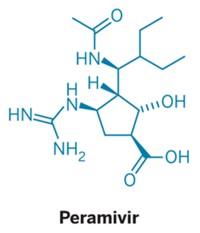Advertisement
Grab your lab coat. Let's get started
Welcome!
Welcome!
Create an account below to get 6 C&EN articles per month, receive newsletters and more - all free.
It seems this is your first time logging in online. Please enter the following information to continue.
As an ACS member you automatically get access to this site. All we need is few more details to create your reading experience.
Not you? Sign in with a different account.
Not you? Sign in with a different account.
ERROR 1
ERROR 1
ERROR 2
ERROR 2
ERROR 2
ERROR 2
ERROR 2
Password and Confirm password must match.
If you have an ACS member number, please enter it here so we can link this account to your membership. (optional)
ERROR 2
ACS values your privacy. By submitting your information, you are gaining access to C&EN and subscribing to our weekly newsletter. We use the information you provide to make your reading experience better, and we will never sell your data to third party members.
Business
The Other Drug For Avian Flu
Relenza is less well-known than Tamiflu, but its use is equally controversial
by Jean-François Tremblay
April 10, 2006
| A version of this story appeared in
Volume 84, Issue 15
As things stand, if an avian flu pandemic breaks out before a vaccine has been developed, the first line of defense is Roche's much-ballyhooed antiviral drug, Tamiflu. As a second choice, doctors will turn to GlaxoSmithKline's Relenza, a drug that is more expensive and harder to obtain.
In the freewheeling drugstores of Hong Kong, pharmacists have seen neither Tamiflu nor Relenza for several months. The local agents for GSK and Roche no longer deliver the drugs to private drugstores, pharmacists say. But whereas drugstore managers expect Tamiflu to soon become available again in local shops, they aren't holding their breath for Relenza.
The World Health Organization (WHO) says that oseltamivir and zanamivir—Tamiflu and Relenza, respectively, by their generic names—have proven effective in reducing the severity and duration of the seasonal flu. Therefore, the drugs "may improve the prospects of survival [from avian flu], if administered early," the agency says.
Peter Cordingley, a Manila-based WHO spokesman, says it may be a good idea to stockpile both drugs in order "to have several options, since we don't know what kind of virus would cause a pandemic." The bird flu virus, also known as H5N1, is still evolving and has not yet developed into a strain that can transmit from human to human.

Kenneth W. T. Tsang, a specialist in respiratory medicine who is an honorary professor at both the University of Hong Kong and Hong Kong Polytechnic University, has a slight preference for Relenza. The possible side effects of Relenza include bronchospasms, which he says are manageable. But trials have shown that a quarter of Tamiflu users develop flulike symptoms that could be the source of much confusion during a pandemic.
Tsang has studied respiratory infections for 15 years and managed patient care in the West Hong Kong region during the 2003 severe acute respiratory syndrome (SARS) crisis. Despite his bias toward Relenza, he does not have much confidence in the effectiveness of either medicine against the H5N1 virus. It's too virulent, he says. Avian flu deaths in Vietnam and Thailand have exceeded 60% even after patients received Tamiflu.
Still, available drugs should be more rigorously tested for their efficacy against the bird flu, he says. Unlike SARS, which hit medical authorities without warning, the avian flu is providing much advance notice of its arrival.
Several governments have ordered Relenza, although Tamiflu remains by far their first choice. Last month, for example, the U.S. Department of Health & Human Services ordered 16.2 million Tamiflu treatment courses but only 3.95 million Relenza treatment courses.
WHO prefers Tamiflu to Relenza, partly because Relenza is more expensive and partly because it believes the GSK drug is unsuitable for people with chronic respiratory problems such as asthma. Similarly, the Hong Kong government, which has ordered 1.5 million Relenza treatments, believes zanamivir to have "relatively low systemic bioavailability."
At issue is the way Relenza is administered. A major difference between Tamiflu and Relenza is that the former is ingested while the latter is inhaled. Roche packs Tamiflu in a box containing 10 blisters. A full course of treatment involves taking the 10 pills over five days. GSK similarly sells Relenza as one course of treatment. The Relenza package contains 20 pills that are to be inhaled over five days with the help of a device known as the Diskhaler.
The GSK inhaler is the source of controversy. WHO spokesman Cordingley says it is too complicated to use. "It is expected to be very difficult to teach people who cannot read or who are not familiar with such devices," he says. He adds that the presence of the inhaler in each box makes stockpiling Relenza difficult. Finally, he says, the device is costly to produce and prevents GSK from offering volume discounts.
The inventor of Relenza, the Australian company Biota, is suing GSK over its allegedly poor performance in promoting the antiviral drug. Part of the problem, Biota says, is that GSK "did not adequately pursue alternative or improved inhalation systems." Biota agreed to license Relenza to GSK in 1990 in exchange for a 7% royalty on global sales of the drug.
Yusuf K. Hamied, the chairman and managing director of Indian generic drug company Cipla, says there is no need to administer Relenza with a complex device like the Diskhaler. His company has developed a generic version of Relenza and has applied to market it in India and the U.S. in con-junction with a lower cost inhaling device.
Cipla will sell its generic zanamivir for the same price as its generic oseltamivir, Hamied predicts. He expects that the U.S. Food & Drug Administration will approve generic oseltamivir and zanamivir in the event of a pandemic.
Controversy has dogged Relenza almost since the product was first approved in 1999 as a treatment for seasonal flu. It led the biostatistician Michael Elashoff to leave FDA. The holder of a Ph.D. in biostatistics from Harvard University, Elashoff was one of the officials reviewing Relenza's clinical trials data. He opined that Relenza should not be approved given that the data he reviewed did not show much effectiveness and that it has potential side effects such as bronchospasms.

In an interview aired by the Public Broadcasting Service in 2003, Elashoff said some asthmatic patients who took Relenza later died from severe bronchospasms. He left FDA, claiming that senior officials relieved him of most of his duties because of his views on Relenza.
Today, Elashoff does not believe that Relenza will work against the bird flu either. "Since it had such limited efficacy against regular flu, it would seem unlikely to have much efficacy against the bird flu," he tells C&EN. Elashoff now runs his own biostatistics consultancy.
In the U.K., where GSK is headquartered, Relenza gave rise to a battle in 1999 between the drug company and the National Health Service, the government agency that funds most hospitals. Then-health minister Frank Dobson instructed doctors not to prescribe Relenza for the seasonal flu because of its price and the potential risks posed by side effects. This led Richard Sykes, chairman of what was then Glaxo Wellcome, to threaten to pull the company out of the U.K. in view of the government's "antagonistic" attitude toward the drug industry.
These setbacks early in the commercial life of Relenza are now water under the bridge as bird flu fears intensify. Until new drugs, or a vaccine, emerge, Relenza is still one of the only two possible ways to treat H5N1, and demand for Relenza is outstripping GSK's ability to meet it.
Relenza had until very recently been a disappointing drug for GSK. According to the pharmaceutical market consultancy IMS Health, worldwide sales of Relenza, based on the manufacturer price, were a mere $8.1 million last year.
According to Sarah J. Stuckey, a GSK spokeswoman based in Australia, it takes more than a year for GSK to fulfill new Relenza orders. "Orders placed now, if in excess of the available existing installed capacity (due to other health agency pandemic stockpiling orders), could not be supplied for at least 18 months," she says.
This suggests that GSK's ability to supply the drug is declining. Diana Kam, a spokeswoman for Hong Kong's Department of Health, says GSK took five months to fulfill an order the agency made last September for 1.5 million Relenza treatments.
Roche recently announced that its capacity for Tamiflu will reach 190 million treatments this year and 400 million in 2007. The company has licensed production of Tamiflu to other companies and is also working with subcontractors to boost supplies.

By contrast, it is difficult to gauge how much progress GSK is making in boosting Relenza capacity. The company answered only a few of C&EN's questions on this subject, despite numerous inquiries. Stuckey does say GSK is now spending close to $100 million on expanding production of Relenza. Of this amount, the company recently spent $15 million to boost Relenza output at a plant in Australia.
As to GSK's current capacity, "we don't provide specific numbers because the number changes as we work on increasing capacity," Stuckey says. She adds that GSK is "open to voluntary licenses with any companies that can assist in our efforts to supply Relenza."
GSK would not provide details on the process it uses to synthesize zanamivir, though Stuckey insists it is complex. A paper published in 1996 in Drugs of the Future describes an eight- to nine-step process. The starting material for Relenza is N-acetylneuraminic acid (NANA), which at present costs $3,000-4,000 per kg, according to Cipla's Hamied. He says he obtains his material from China.
CMS Chemicals, a British specialty chemical manufacturer, recently announced that it will be producing several tons of NANA in Slovakia, making use of an enzymatic process developed by Germany's J??lich Research Center. The process was later refined by CMS and J??lich Chiral Solutions, an enzyme developer based near the research center. CMS says the NANA produced could be used to make Relenza and in nutraceutical formulations.
Although some research shows that Relenza may be more effective than Tamiflu against H5N1, GSK is focusing mostly on the development and production of an effective vaccine. The $100 million or so the company is spending to boost Relenza's output pales in comparison to the almost $2 billion it claims to be investing in bird flu vaccine development. GSK announced late last month that it was initiating clinical trials of two avian flu vaccines in Europe.
In Hong Kong, respiratory diseases specialist Tsang agrees that R&D efforts should be applied to developing a vaccine rather than new courses of treatments. Immunizing humans will allow life to continue more normally in the event of a pandemic, he says. Furthermore, he adds, H5N1 has shown it can grow resistant to antiviral drugs.
But the possibility of a pandemic should be kept in perspective, Tsang says. Since 2003, roughly 100 people worldwide have died of the bird flu. A clearer danger is posed by the seasonal flu, which, according to the Centers for Disease Control & Prevention, kills about 50,000 per year in the U.S. alone.






Join the conversation
Contact the reporter
Submit a Letter to the Editor for publication
Engage with us on Twitter